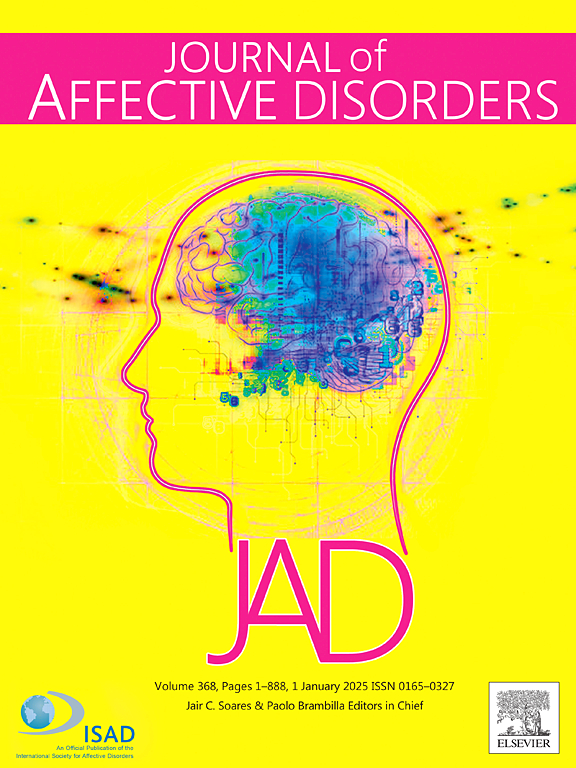Neurocognitive correlates of emotion-based urgency in DSM-5 bipolar disorder: the moderating role of diagnosis status and positive affect in a functional near-infrared spectroscopy (fNIRS) experimental study
IF 4.9
2区 医学
Q1 CLINICAL NEUROLOGY
引用次数: 0
Abstract
Background
A key goal of clinical neuroscience is to uncover reliable neurobiological targets for treatment. Urgency (negative or positive urgency subdomains, or N.urg/P.urg respectively), or affect-based impulsivity, is clinically relevant in bipolar disorder (BD). However, the neurocognitive correlates of positive and negative urgency have been mixed, with few considering the moderating effects of BD diagnosis and positive emotional context.
Methods
We conducted a 2 (group: BD vs. gender-matched healthy controls, or HC) by 2 (condition: positive vs. neutral affect) by 2 (task difficulty; within subjects) mixed, single-blind study. We examined neurocognitive correlates of urgency using EF performance and neuroimaging data from 74 participants (60 % females, Mage = 36).
Results
Between-group differences (HC > BD) in EF performance ranged from negligible to large (ηp2: 0 to 0.18). At the p < .05 threshold, positive urgency was correlated with lower cognitive control and working memory efficiency (r ranging from 0.25 to 0.34, p < .05). N.urg was correlated with reduced activity in the ventrolateral PFC (vlPFC) during cognitive control (r = −0.26 to −0.29, p < .05). Multivariate Analysis of Variance (MANOVA) and subsequent simple slopes analyses revealed significant moderation by emotional context and BD diagnosis. High N.urg predicted hypoactivity in the left orbitofrontal cortex in BD only, whereas high P.urg predicted hyperactivity in the right vlPFC in positive emotion context condition only. No correlations/MANOVA findings remained significant after p-value correction.
Conclusion
Notwithstanding the study's limitations, the nature of the relationship between urgency and neurocognitive factors may be person- and context dependent.
功能近红外光谱(fNIRS)实验研究:诊断状态和积极情绪在DSM-5双相情感障碍中情绪紧迫感的神经认知相关
背景:临床神经科学的一个关键目标是发现可靠的神经生物学治疗靶点。紧急(消极或积极的紧急子域,或N.urg/P。或基于情感的冲动,在双相情感障碍(BD)中具有临床相关性。然而,积极和消极急迫性的神经认知相关性已经混合,很少考虑双相障碍诊断和积极情绪背景的调节作用。方法:我们进行了一项2(组:双相障碍与性别匹配的健康对照,或HC) × 2(条件:积极与中性情绪)× 2(任务难度;在受试者内)混合,单盲研究。我们利用74名参与者(60 %女性,Mage = 36)的EF表现和神经影像学数据检查了紧迫感的神经认知相关性。结果:组间差异(HC > BD) EF表现从可忽略到较大(ηp2: 0 ~ 0.18)。然而,在p 结论:尽管研究的局限性,紧迫性和神经认知因素之间关系的本质可能是个人和环境依赖的。
本文章由计算机程序翻译,如有差异,请以英文原文为准。
求助全文
约1分钟内获得全文
求助全文
来源期刊

Journal of affective disorders
医学-精神病学
CiteScore
10.90
自引率
6.10%
发文量
1319
审稿时长
9.3 weeks
期刊介绍:
The Journal of Affective Disorders publishes papers concerned with affective disorders in the widest sense: depression, mania, mood spectrum, emotions and personality, anxiety and stress. It is interdisciplinary and aims to bring together different approaches for a diverse readership. Top quality papers will be accepted dealing with any aspect of affective disorders, including neuroimaging, cognitive neurosciences, genetics, molecular biology, experimental and clinical neurosciences, pharmacology, neuroimmunoendocrinology, intervention and treatment trials.
 求助内容:
求助内容: 应助结果提醒方式:
应助结果提醒方式:


